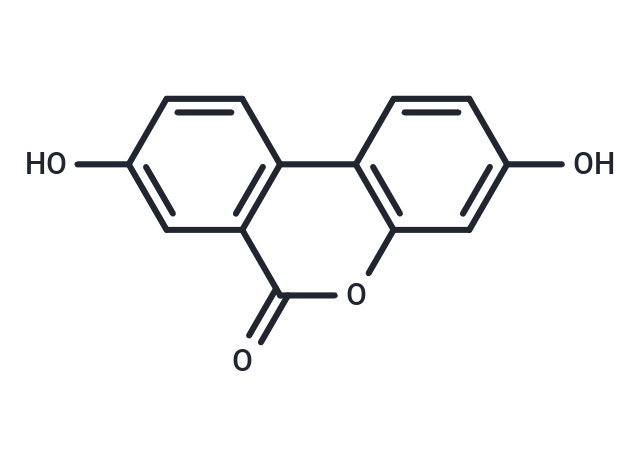Shopping Cart
Remove All Your shopping cart is currently empty
Your shopping cart is currently empty
Urolithin A is a natural product, a metabolite of ellagic acid, which inhibits DNA synthesis and induces apoptosis and autophagy. Urolithin A exhibits antioxidant, anti-inflammatory and antitumor activities.

| Pack Size | Price | USA Warehouse | Global Warehouse | Quantity |
|---|---|---|---|---|
| 5 mg | $42 | In Stock | In Stock | |
| 10 mg | $66 | In Stock | In Stock | |
| 25 mg | $132 | In Stock | In Stock | |
| 50 mg | $197 | In Stock | In Stock | |
| 100 mg | $337 | In Stock | In Stock | |
| 200 mg | $497 | - | In Stock | |
| 500 mg | $793 | - | In Stock | |
| 1 mL x 10 mM (in DMSO) | $46 | In Stock | In Stock |
| Description | Urolithin A is a natural product, a metabolite of ellagic acid, which inhibits DNA synthesis and induces apoptosis and autophagy. Urolithin A exhibits antioxidant, anti-inflammatory and antitumor activities. |
| Targets&IC50 | T24 cells:43.9 μM, Caco-2 cells:49 μM, St-T1b cells:39.88 µM, CK2:0.39 𝜇M, SW620 cells:53.561 μM, 12Z endometriotic cells:40.46 µM |
| In vitro | METHODS: Human colorectal cancer cells SW620 were treated with Urolithin A (0-30 µM) for 24 h. Cell viability was measured by MTT assay. RESULTS: A dose-dependent decrease in proliferation was observed in Urolithin A-treated cells. [1] METHODS: Human colorectal cancer cells HT29, SW480 and SW620 were treated with Urolithin A (20-100 µM) for 48 h, and the expression levels of target proteins were detected by Western Blot. RESULTS: Treatment of CRC cells with different concentrations of Urolithin A resulted in a significant increase in Cyclin B1 and CDK6, suggesting a strong cell cycle accumulation in G2/M phase. [2] |
| In vivo | METHODS: To investigate the effects on Alzheimer's disease (AD), Urolithin A (300 mg/kg, 0.5% carboxymethylcellulose) was administered orally once daily for 14 days to APP/PS1 mouse models. RESULTS: Urolithin A ameliorated cognitive deficits, prevented neuronal apoptosis, and enhanced neurogenesis in APP/PS1 mice.Urolithin A attenuated Aβ deposition and periplaque microglia and astrocyte hyperplasia in the cortex and hippocampus. Urolithin A affects key cell signaling pathways, particularly by enhancing brain AMPK activation, decreasing activation of P65NF-κB and P38MAPK, and inhibiting degradation of Bace1 and APP. [3] |
| Molecular Weight | 228.2 |
| Formula | C13H8O4 |
| Cas No. | 1143-70-0 |
| Smiles | Oc1ccc2c(c1)oc(=O)c1cc(O)ccc21 |
| Relative Density. | 1.516 g/cm3 (Predicted) |
| Storage | keep away from direct sunlight | Powder: -20°C for 3 years | In solvent: -80°C for 1 year | Shipping with blue ice/Shipping at ambient temperature. | |||||||||||||||||||||||||||||||||||
| Solubility Information | DMSO: 242.5 mg/mL (1062.66 mM), Sonication is recommended. | |||||||||||||||||||||||||||||||||||
| In Vivo Formulation | 10% DMSO+40% PEG300+5% Tween 80+45% Saline: 5 mg/mL (21.91 mM), Solution. Please add the solvents sequentially, clarifying the solution as much as possible before adding the next one. Dissolve by heating and/or sonication if necessary. Working solution is recommended to be prepared and used immediately. The formulation provided above is for reference purposes only. In vivo formulations may vary and should be modified based on specific experimental conditions. | |||||||||||||||||||||||||||||||||||
Solution Preparation Table | ||||||||||||||||||||||||||||||||||||
DMSO
| ||||||||||||||||||||||||||||||||||||
| Size | Quantity | Unit Price | Amount | Operation |
|---|

Copyright © 2015-2025 TargetMol Chemicals Inc. All Rights Reserved.